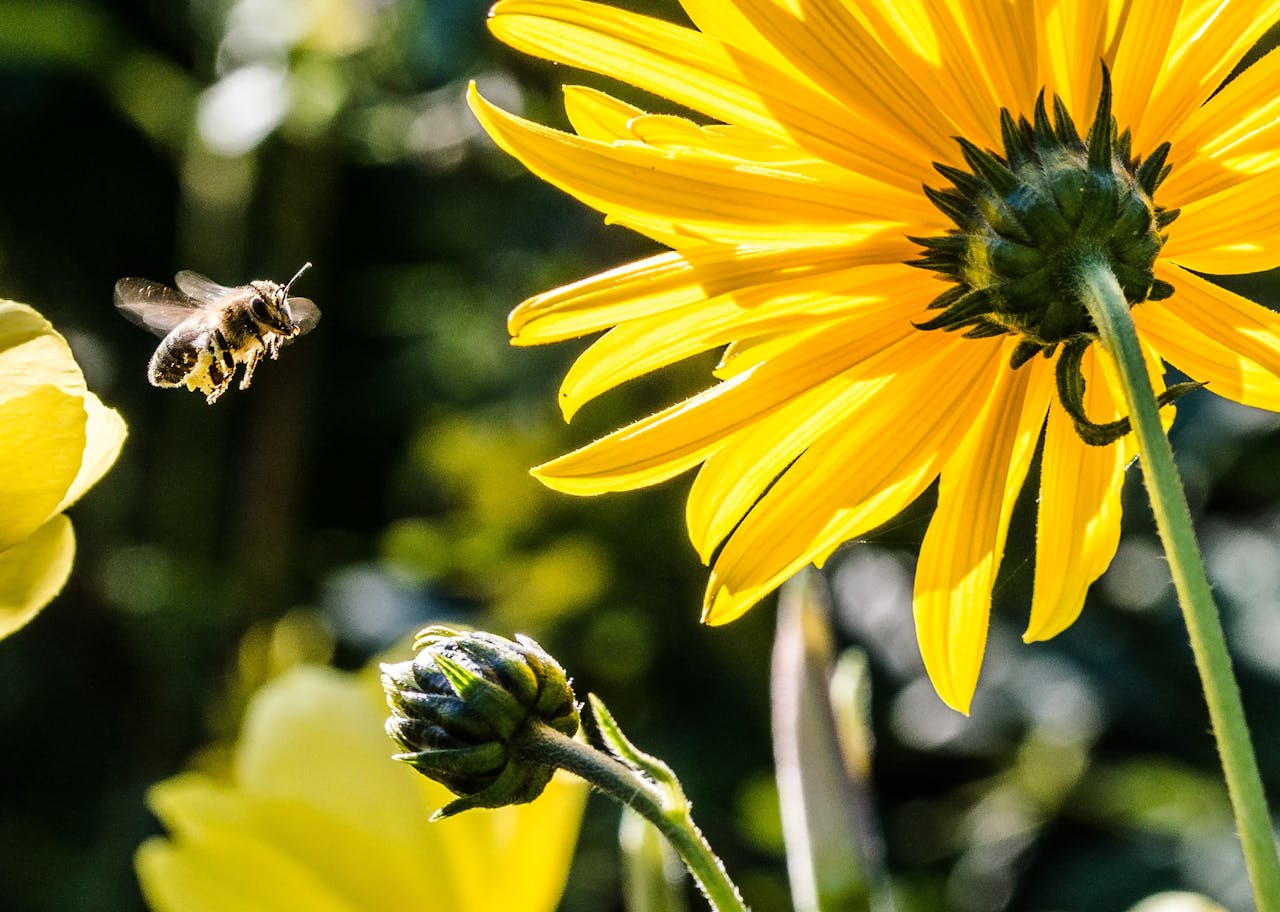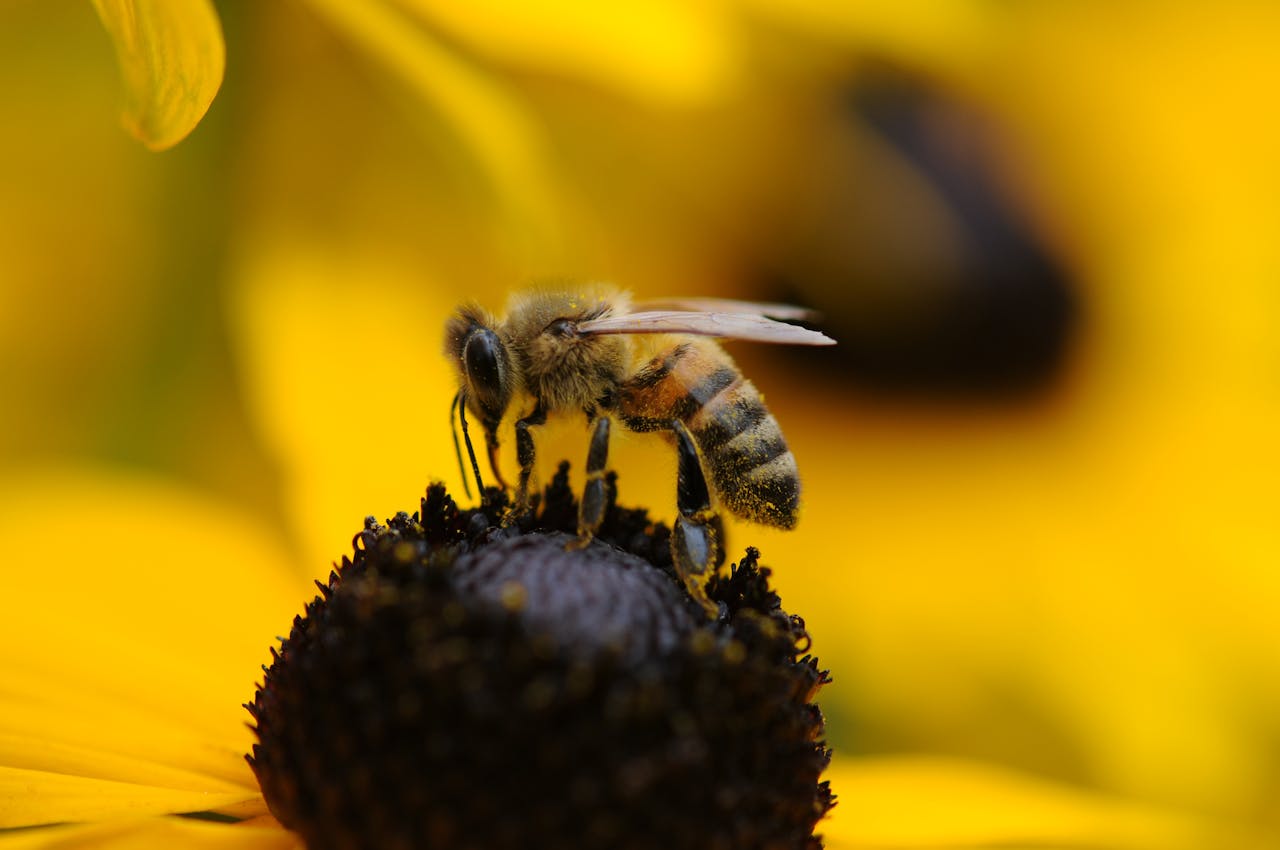In this article, we'll walk you through practical tips and techniques for photographing bees, from understanding their movements to mastering the right equipment and settings.
Understanding Bee behavior
Bees are most active during warm, sunny parts of the day, typically between mid-morning and early afternoon. These are the best times to find them buzzing around flowers. Early morning or late evening, when the air is cooler, bees move more slowly, making them easier to photograph.
Different types of bees have specific flower preferences. For example, honeybees and bumblebees often visit brightly colored flowers rich in nectar, such as lavender, sunflowers, or wildflowers. Observing which plants attract bees in your area can help you choose the best spots for photography.
Pay attention to how bees interact with flowers. They often hover briefly before landing, giving you a chance to capture them in flight. Once they land, they gather nectar and pollen, moving methodically between flowers. Watching their patterns can help you anticipate their next move and position yourself for the perfect shot.
It’s also helpful to recognize when a bee is resting or grooming itself. These quieter moments are ideal for capturing close-up shots without movement blur.
Equipment recommendations
While you don’t need the most expensive gear, certain tools can help you capture sharper, more detailed images. Here’s what to consider:
- Camera gear: A DSLR or mirrorless camera is ideal because they offer manual control over settings like shutter speed and aperture. These controls are essential for freezing fast-moving bees or creating a shallow depth of field to make the bee stand out.
- Lenses: A macro lens is the best choice for capturing close-up details like the texture of a bee's body or its delicate wings. A focal length between 90mm and 150mm gives you the flexibility to shoot without getting too close and disturbing the bee. If a macro lens isn’t an option, a telephoto lens with a short minimum focusing distance can work well for capturing bees from farther away.
- Tripod or monopod: A sturdy tripod helps keep your camera stable for sharper images, especially when using slower shutter speeds. A monopod is a lighter, more portable option for maintaining stability while moving between shots.
- Lighting equipment: Bees often move in areas where natural light may be uneven, like under the shade of plants. An external flash with a diffuser can provide balanced, soft lighting without casting harsh shadows or scaring the bees away.
- Close-up accessories: If you’re on a budget, extension tubes or close-up filters can turn a regular lens into a macro lens. These options are affordable and lightweight, making them great for beginners.
Investing in the right equipment gives you more control over your images, but remember that it’s not just about the tools. Patience, observation, and a good understanding of bee behavior will always be your most valuable assets.

Location scouting
Bees are naturally drawn to areas rich in flowering plants, so focus on places with abundant blooms. Local parks, botanical gardens, and wildflower meadows are excellent options. These locations often have a variety of plants, attracting different species of bees and offering diverse photographic opportunities.
If you want more control over the setting, consider visiting a local apiary. Many beekeepers allow visitors to observe and photograph bees in a safe and structured environment. This can be a great way to get closer to bees without searching for them in the wild. Always ask for permission and follow the beekeeper's guidelines to avoid disturbing the hives.
Your own backyard can also be a great location if you plant flowers that bees love, such as lavender, sunflowers, or clover. By observing your garden over time, you’ll learn when and where bees are most active, giving you plenty of chances to photograph them.
When scouting a location, pay attention to the lighting and weather. Look for spots with good natural light, as it can highlight the bee’s details and create vibrant images. Also, check for shaded areas where you can capture bees without harsh sunlight creating strong contrasts.
Creative ideas for Bee photography
One idea is to focus on bees in flight. These shots are challenging but can be striking when done well. Position yourself near a flower where bees are actively feeding, and use a fast shutter speed to freeze their motion mid-air.
Another creative approach is to photograph bees interacting with their environment. Capture them as they crawl over flowers, collect pollen, or rest on leaves. These moments tell a story about their role in nature and create a connection between the viewer and the bee's world.
Experiment with angles—shooting from below can emphasize the bee's relationship with the flower, while a side profile can highlight its body and features.
You can also play with depth of field to make the bee stand out. Using a shallow depth of field keeps the bee in sharp focus while blurring the background into soft, dreamy colors. This technique works especially well when the surroundings are vibrant, such as in gardens or wildflower meadows.
Look for unique perspectives to make your photos stand out. For example, try shooting a bee head-on to capture its large eyes and fuzzy face. Alternatively, zoom in on details like its legs covered in pollen or the patterns on its wings. These close-up shots reveal features that are often missed by the naked eye.
Consider incorporating motion blur creatively. Instead of freezing the bee completely, allow a slight blur in the wings to convey movement while keeping the body sharp. This adds energy to the shot and makes it feel alive.
Lastly, don’t limit yourself to sunny days. Overcast conditions can create soft, even lighting that reduces harsh shadows and brings out subtle details. Rainy days might also offer opportunities to photograph bees seeking shelter or interacting with water droplets on plants.
The key to creative bee photography is experimentation. Try different techniques, angles, and settings to see what resonates with your style.
